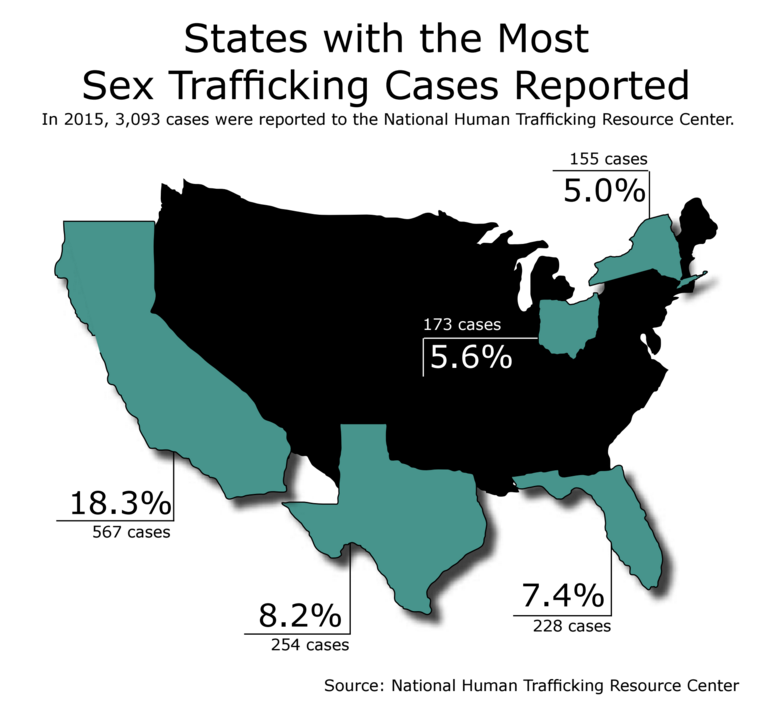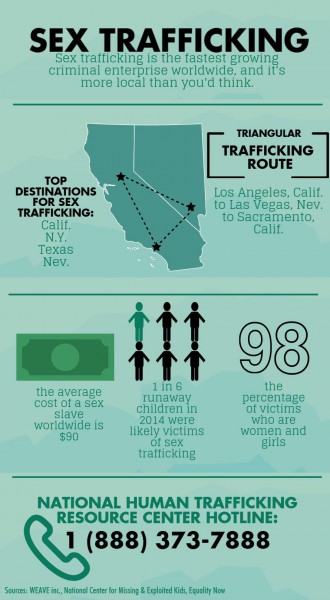Sex trafficking an international and local problem

By Laura Bock and Cassie Archer,
BlueDevilHUB.com Staff–
When the phrases “human trafficking” and “modern slavery” are used, images of developing countries often come to mind. However, sex trafficking is in fact more local than many people dare to imagine.
According to WEAVE, the United States is one of the top three destinations points for sex trafficking victims. Inside the U.S., California has the highest number of sex trafficking cases reported.
Even more locally, Sacramento itself has a serious problem. Deputy District Attorney for the Sacramento County Sonia Satchell says that sex trafficking is a problem in Sacramento because, although Sacramento does not have the reputation of a big city, “we are in fact a very large city and county. As in any urban environment, we see more of these type of activities.”
Although there are known “strolls”–areas known for prostitution–in Sacramento, Satchell also said that many people are targeted via social media.
“I can’t stress enough for people to be safe on the internet and social media. Everyone thinks it can’t happen to them and with smartphones and all these social media apps, everyone is a target,” said Satchell, who works in the sex trafficking unit prosecuting those who violate crimes and taking cases to jury trial.
She added that victims are often “lured by the flashy idea of pimp game” on social media. This is what is referred to as “pimp culture.”
The false lure of pimp culture

Pimp culture is often glamorized by mainstream pop culture, making it seem like an attractive way of life. Celebrities like Snoop Dogg (who, in a Rolling Stone article, said that “pimpin’ aint a job, it’s a sport”) and songs like “P.I.M.P.” by 50 Cent, among countless other examples, make being a pimp seem appealing and even fun. This can encourage boys and men to want to become pimps.
Pimp culture also works in another way: many girls voluntarily choose to become prostitutes.
“A lot of the cases I have are girls and women who for some reason find the life of prostitution appealing. It is usually the easy money that appeals to them, but soon enough they are having to work against their will,” Satchell said.
However, pimp culture itself is very different from its common portrayal.
“Men usually have a group of women that they force, on some level, to prostitute,” Satchell explained. “There is usually a main girl and it’s her job to teach and keep the other girls in line. The pimp has to make sure that his girls do what he says and depend exclusively on him.”
One way that pimps and traffickers ensure their girls’ dependence on them is through physical, emotional and economic abuse. Some pimps even brand their prostitutes as their property. This makes it very difficult for victims to escape.
According to Shared Hope International, “traffickers are master manipulators and employ tactics to create trauma bonds with victims. Traffickers often use the threat of violence against victims or victim’s loved ones to secure their submission.”
Victims come from all walks of life
Though anybody can become a sex trafficking victim, many victims have similar backgrounds, according to Satchell.
“Victims of human trafficking, girls and boys, tend to come from abusive backgrounds or the foster care system,” Satchell said. “They have low self-esteem and are looking for validation elsewhere.”
WEAVE found that certain groups are also especially at risk, including the homeless, runaways and undocumented immigrants. Age is also a target–the younger the victim, the easier it is for pimps to manipulate them and sell them into sex trafficking.
Victims are also sold into sex trafficking in numerous ways–some victims are sold by their parents or other family members, others are kidnapped and, in some cases, victims are lured in by false marriage proposals or relationships.
The latter is fairly common, especially due to the increased prominence social media. Shared Hope International describes the technique, saying that pimps often pose as “lover-boys” to woo middle school and high school girls. These lover-boys win the girls’ love and trust by making false promises, and then force them into prostitution.
Reaching out to victims
In the summer before her junior year, Davis High senior Tatiana Pellow travelled to Tijuana with a Redding church to help build a safe house for prostitutes and trafficking victims. There, she got to interact with victims and helped them escape prostitution, get jobs and undergo therapy sessions.
Pellow said music was often therapeutic for victims.
“When we built the safe house, we brought a lot of instruments for [the victims], and a lot of the people I worked with were really good at music,” Pellow said, “so they would play and teach some of them how, but a lot of victims actually already knew how to play piano or guitar or something, so we had them play together.”
Because Pellow was under 18, most of her work was done within the safe house. There was also another group, which worked to rescue victims from brothels, but Pellow wasn’t involved because it often put the volunteers in dangerous situations.
While working in the safe house, she was affected by the women’s stories.
“One of them, while talking to me, got really emotional when talking about her daughter,” Pellow recalled. “She wasn’t [prostituting] for herself, she was doing it for her daughter [because] there’s a lot of poverty and she was trying to feed her daughter.”
Pellow said that her trip definitely changed her perspective on prostitution.
“I’d say that before this trip I had a negative view of prostitution, but from [this trip] I got that the people were really good people and that some of them were doing it because they were choosing to do it,” she said. “But a lot of them were forced into it, which is really sad and I think a lot needs to be done about it.”
The trip also caused Pellow to want to help out trafficking victims in the future.
“There needs to be not just international help, but help around here,” Pellow said.
Taking legal action
Because sex trafficking is an underground, illegal activity, it is difficult to say exactly how many pimps and traffickers either go unnoticed by the law or go free compared to the number who are arrested. In fact, it’s more common that victims of sex trafficking are the ones who are arrested, even though they were forced into a life of prostitution.
However, Satchell says that the law is aware of that fact and notes that law enforcement tries to determine whether or not the arrested prostitutes are trafficking victims.
“Victims of sex trafficking are just victims,” she said. “If a victim is cooperative and honest with us, she doesn’t have to worry. However, prostitution is illegal and you can be arrested for that, but usually after a thorough investigation we can determine whether the girl is doing this willingly or not.”
Satchell says the process of sending a trafficker to jail begins with a police arrest and report, which is passed along to the District Attorney’s Office.
“We make the decision as to whether or not there is sufficient evidence to file charges,” Satchell explained. “Once they are charged with a crime, they are arraigned on the charges. Usually an early resolution offer is made, though not always; if no agreement is reached we do a preliminary hearing and then a jury trial.”
If you see something, say something
If you suspect that somebody is a victim of sex trafficking, report it to the police and/or call the National Human Trafficking Resource Center hotline at 1 (888) 373-7888.



